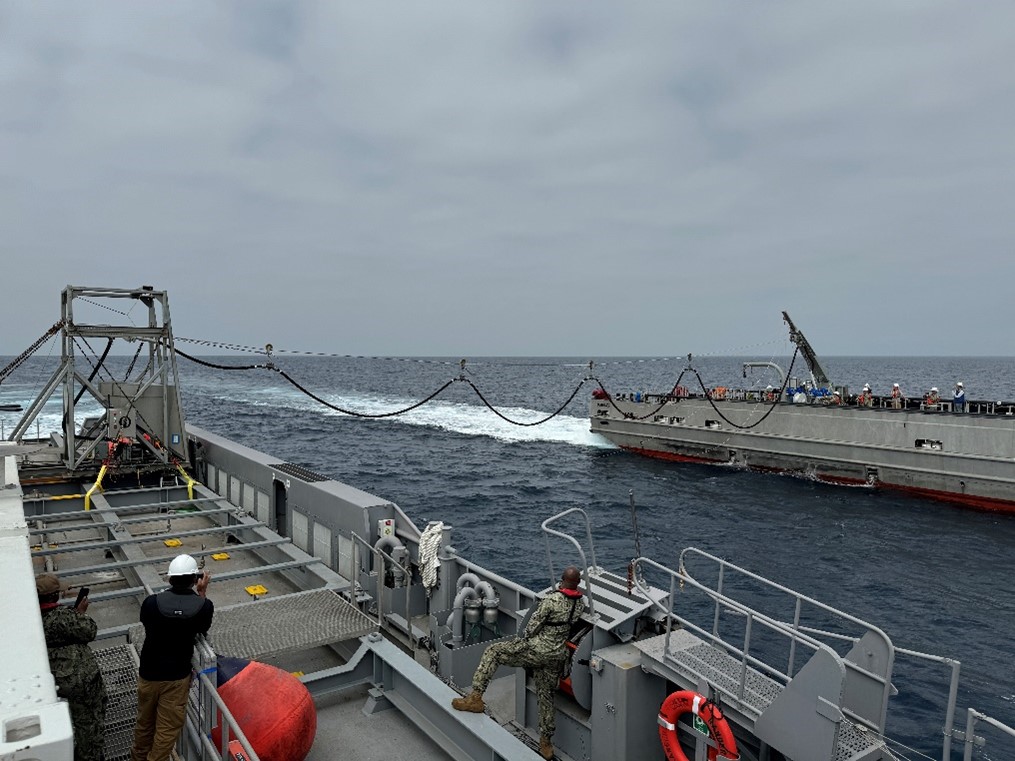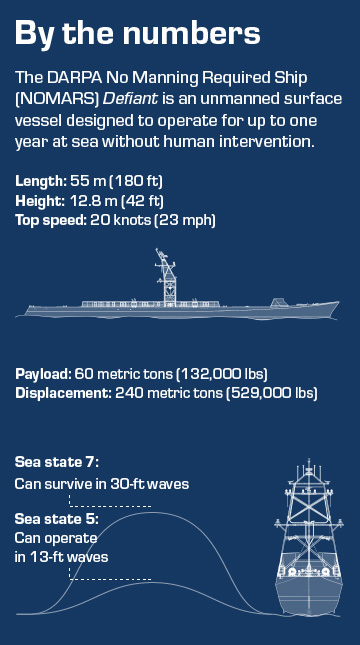Feature
Revolutionizing naval capability
Meet a first-of-its-kind unmanned ship
The No Manning Required Ship (NOMARS) program has built an unmanned surface vessel (USV) designed from the ground up to never accommodate a human aboard, the USX-1 Defiant.
By removing the human element from all ship design considerations, the program intends to demonstrate significant advantages, to include: Size, cost, at-sea reliability, greater hydrodynamic efficiency, survivability to sea-state, and survivability to adversary actions.
NOMARS is the kind of experimentation that could define a future hybrid maritime fleet, a manned-unmanned team with the ability to adapt and scale.
Bookmark this page to follow along as Defiant undergoes an extended at-sea demonstration of reliability and endurance, showcasing what’s possible when we rethink how we design, build, operate, and maintain ships.
We recently marked a historic milestone with the christening of the USX-1 Defiant in Everett, Wash. This moment represents the culmination of years of hard work by a dedicated team determined to push the boundaries of what’s possible at sea.
Source: DARPA | Spencer Bruttig
Follow the Defiant
Sept. 17, 2025
Milestones at Port Hueneme
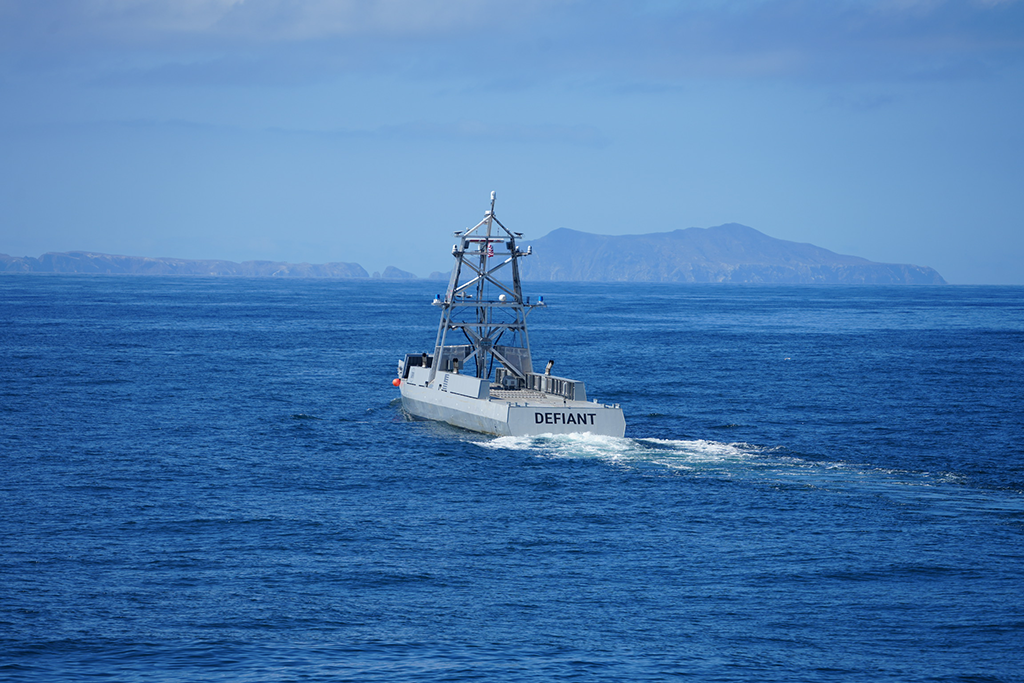
Defiant sails in the waters off Port Hueneme.
Source: DARPA | Matt Rising
During a week at Naval Base Ventura County (NBVC) Port Hueneme, California, the NOMARS team continued to validate the capabilities of the USX-1 Defiant. Among other achievements, the team successfully demonstrated at-sea fueling (using water instead of fuel for the demo) without anyone aboard the Defiant. The team also tested high-speed turns and pushed the ship's straight-line speed close to 20 knots. Defiant also achieved multiple successful dockings/undockings and harbor entries/exits using its autonomy system.
The NOMARS program successfully demonstrated fueling at sea (FAS) capabilities for the USX-1 Defiant in the waters near Port Hueneme, Calif.
Source: DARPA | Matt Rising
NBVC Port Hueneme is the center of the U.S. Navy’s unmanned operations. Sailors from Unmanned Surface Vessel Squadron (USVRON) One, based at NBVC, have been engaged in Defiant’s sea trials to experience up-close and hands-on the capabilities of the first-of-its-kind USV.
The demonstration mirrored standard refueling concept of operations (CONOPS) as closely as possible, including passing the lead-line to the refueling side, passing and connecting the refueling probe to the Defiant, and pumping water – all without anyone ever aboard the Defiant. With this round of capability testing complete, Defiant is back out to sea to continue its extended demonstration of reliability and endurance.
Sept. 8, 2025
NOMARS arrives at Port Hueneme
Defiant sails into Port Hueneme, Calif., completing its first open-ocean transit.
Source: DARPA | Sarah Sutton
The USX-1 Defiant pulls into Port Hueneme, California, after completing her first open-ocean transit. The vessel sailed more than 1,100 nautical miles in five days down from Port Angeles, Washington.
Sept. 4, 2025
Defiant sets sail
Defiant sails in the waters near Port Angeles, Wash., closing out her pre-departure testing.
Source: Serco North America, DARPA | Spencer Bruttig
The USX-1 Defiant has set sail, beginning her extended at-sea demonstration of endurance and reliability. She completed pre-departure testing in the waters near Port Angeles, Washington, before sailing up the Strait of Juan de Fuca. The ship reached the Pacific Ocean early this morning.
Aug. 11, 2025
Defiant demonstrates path to strengthen naval fleet
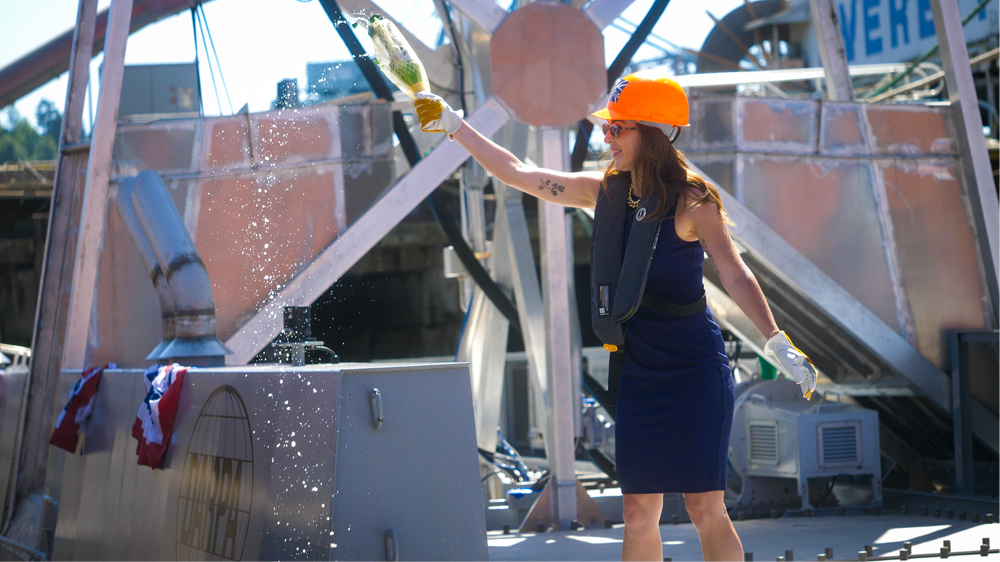
Ship sponsor Mattie Hanley follows naval tradition by breaking a bottle of spirits on the side of the USX-1 Defiant during the official christening ceremony in Everett, Wash., on Aug. 11, 2025.
Source: DARPA | Spencer Bruttig
DARPA has marked a traditional naval milestone with the christening of USX-1 Defiant, a first-of-its-kind autonomous, unmanned surface vessel designed from the ground up to never accommodate a human aboard. The ceremony took place Monday, Aug. 11, at Everett Ship Repair in Everett, Washington.
The demonstrator for the No Manning Required Ship (NOMARS) program, the Defiant, has a simplified hull design to allow rapid production and maintenance in nearly any port facility or Tier III shipyard that traditionally supports yacht, tug, and workboat customers.
The 180 foot-long, 240-metric-ton lightship is completing final systems testing in preparation for an extended at-sea demonstration of reliability and endurance.
“Defiant is a tough little ship and defies the idea that we cannot make a ship that can operate in the challenging environment of the open ocean without people to operate her,” said NOMARS Program Manager Greg Avicola, during the ceremony. “While relatively small, Defiant is designed for extended voyages in the open ocean, can handle operations in sea state 5 with no degradation and survive much higher seas, continuing operations once the storm passes. She’s no wider than she must be to fit the largest piece of hardware and we have no human passageways to worry about." | Learn more
Aug. 5, 2025
Tackling both sides of the autonomy problem
NOMARS Program Manager Greg Avicola talks about the opportunities and challenges embraced in creating a first-of-its-kind ship.
Source: DARPA | Tom Shortridge
Greg Avicola, NOMARS program manager, shares the importance of platform design in achieving successful autonomous systems. Designing a ship from the ground-up without any provision for people makes it possible to optimize the platform for autonomous operation.
But without people onboard to maintain systems, ensuring reliability in the harsh maritime environment becomes the new hardest problem.
March 3, 2025
Defiant is in the water!
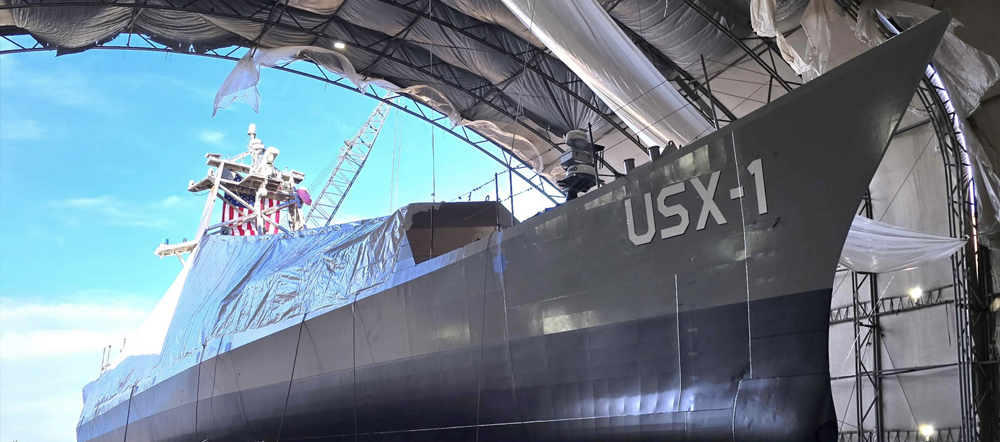
Construction is complete of the USX-1 Defiant, the demonstrator vessel for the NOMARS program. The 180-foot-long, 240-metric-ton lightship is in the waters of Puget Sound, Wash., where it will undergo in-water testing of all its component systems and integration.
The NOMARS program aims to challenge the traditional naval architecture model, designing a seaframe (the ship without mission systems) from the ground up with no provision, allowance, or expectation for humans on board. By removing the human element from all ship design considerations, the program intends to demonstrate significant advantages, to include: Size, cost, at-sea reliability, greater hydrodynamic efficiency, survivability to sea-state, and survivability to adversary actions through stealth considerations and tampering resistance.
With scaled production, NOMARS has the potential to efficiently and cost-effectively deliver a distributed USV fleet.
Dec. 19, 2024
Automated fueling-at-sea test completed
Fueling at sea (FAS) for USVs presents a problem that needs to be solved as current FAS solutions use personnel to handle lines and hoses on the platform being refueled. The NOMARS FAS approach is designed for operation without any human on the USV – but does have humans on the refueling vessel.
The FAS approach mirrors a standard refueling concept of operations (CONOPs) as closely as possible to be familiar to Military Sealift Command (MSC) oiler crew and reduce their learning curve.
For the recent test, USV Ranger carried a receiving station representative of the system that will be on the NOMARS USV Defiant, and USV Mariner carried a refueling “mini-station,” custom-designed by NOMARS prime contractor Serco Inc. | Learn more
